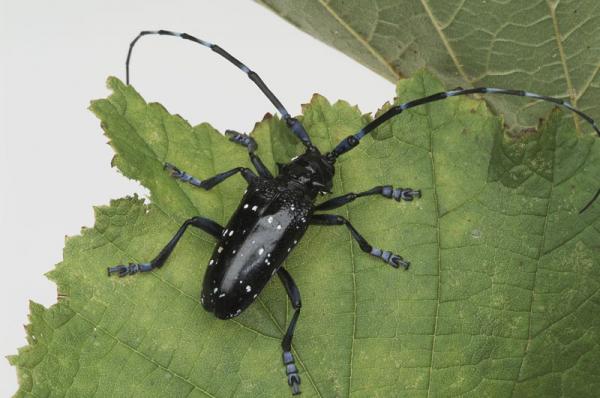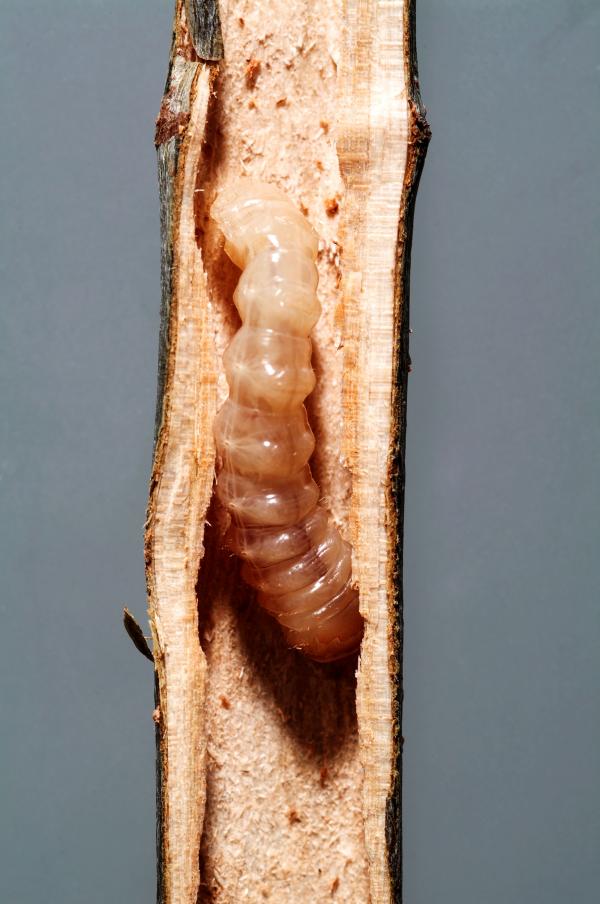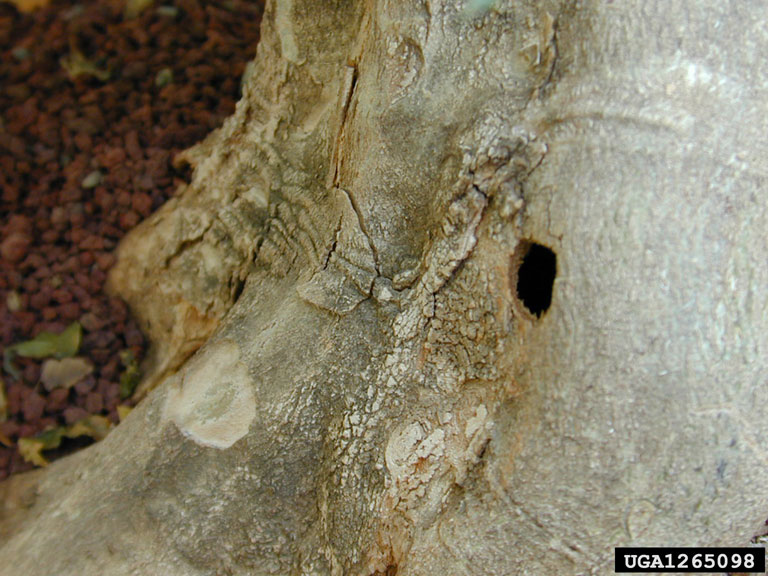Not present in UK
Notifiable – See ‘Report a sighting’ below
Scientific name – Anoplophora chinensis (A. chinensis)

The citrus longhorn beetle (CLB) is a non-native, wood-boring, cerambycid beetle which is extremely damaging to a wide range of broadleaved tree and shrub species. These include several species native to the United Kingdom (UK), and several which are grown for commercial and amenity purposes here.
It is a quarantine pest for the European Union (EU), and beetles have been found around the world in ornamental trees exported from Asia.
It is also known as the black and white longhorn beetle and the citrus root cerambycid.
Distribution
Citrus longhorn beetle’s natural range includes China, Japan, the Korean Peninsula and South-East Asia.
There have been outbreaks (breeding populations) in several European countries.
There have been no known outbreaks of the beetle in the UK. However, there have been numerous interceptions of individual beetles here since 2005, as well as in continental Europe, demonstrating that there is a significant threat to the UK. Most of the beetles found in the UK were associated with Japanese maple trees (Acer palmatum) imported from China.
There have also been interceptions of individual beetles in the USA.
The threat
Citrus longhorn beetle can attack a very wide range of deciduous tree and shrub species, including several species native to the UK. (See ‘Susceptible species’ below).
This means that its introduction and establishment in the UK could pose a serious economic threat to our forestry, fruit growing and other horticultural industries, and to our native trees and woodland, disrupting woodland ecology and biodiversity. Some of the species it can attack, such as plane trees (Platanus species), are popular amenity trees in towns and cities, so some of our urban landscapes could be threatened as well.
The larval (grub) stage of the beetle’s life cycle is the most damaging, because the larvae feed internally on the pith and vascular systems of the lower trunk and root.
The tunnels created by their feeding leave trees weakened and susceptible to diseases and wind damage. The adults (beetles) can cause more-limited damage by feeding on foliage and eating young bark. Compounding the problem is that the pest spends most its life cycle concealed inside the tree or shrub, with little external evidence of its presence until after it has done most of its damage.
Outbreaks in EU Member States in continental Europe have led to the destruction of thousands of mature trees, and eradication costs of millions of euros.
Susceptible species
A European Commission emergency measure passed in 2008 to prevent CLB being accidentally introduced to the EU cited the following species of trees and shrubs known to be hosts of CLB.
Apple (Malus species.), alders (Alnus spp.), beech (Fagus spp.), birch (Betula spp.), cherry (Prunus spp.), citrus spp., Cotoneaster spp., crape or crepe myrtle (Lagerstroemia spp.), elm (Ulmus spp.), hazel (Corylus spp.), hornbeam (Carpinus spp.), horse chestnut (Aesculus spp.), maples (Acer spp.), pear (Pyrus spp.), plane (Platanus spp.), poplar (Populus spp.) and willow (Salix spp.).
Identification and symptoms
Adult beetles (top picture) are large and black with variable white markings. Their bodies vary in length from 21 mm for males to 37 mm (0.8 to 1.5 inches) for females.
The antennae, or ‘horns’, are particularly distinctive: they are longer than their bodies (between 1.2 and two times the body length), and are black with white or light blue bands.
They are very similar in appearance to the related Asian longhorn beetle (Anoplophora glabripennis), another highly damaging pest of a wide range of tree and shrub species.
See ‘Life cycle’ below for details about the eggs, larvae and pupae.

The species spends most of its life as larvae inside a trunk or root (above), so there can be few or no external symptoms of its presence.

Picture: Art Wagner, US Department of Agriculture – APHIS, Bugwood.org
However, adult beetles make a distinctive circular hole (pictured) in the bark when they emerge from their larval and pupation stages. Typically 6-11 mm wide (0.25 – 0.4 in), the holes are mostly found towards the base of trunks and exposed roots. On smooth-barked trees they resemble drilled holes.
Other, less obvious symptoms include scars or slits on the bark at sites where eggs have been laid, and piles of frass (sawdust-like droppings) at the base of an attacked tree.
In thin-stemmed trees, bulges in the trunk can indicate the presence of a pupal chamber.
This factsheet provides further guidance to identifying citrus longhorn beetles.
Report a sighting
Please report suspected sightings in the wider environment (outside plant trade premises) immediately to the appropriate plant health authority:
- Report sightings in Great Britain to us with our TreeAlert pest reporting tool.
- Report sightings in Northern Ireland to the Irish plant health authorities using TreeCheck, the all-Ireland pest reporting tool.
Note that TreeAlert and TreeCheck both require clear, well lit digital photographs of the pest and/or symptoms of its presence.
Suspected sightings, especially sightings within the plant trade, can also be reported:
- in England or Wales – to the Plant Health & Seeds Inspectorate (PHSI) of the Animal and Plant Health Agency (APHA) on planthealth.info@apha.gov.uk; tel: 0300 1000 313;
- in Scotland – to the Scottish Government on hort.marketing@gov.scot; tel: 0131 244 8923; and
- in Northern Ireland – to the Department of Agriculture, Environment & Rural Affairs (DAERA) on planthealth@daera-ni.gov.uk; tel: 0300 200 7847.
If possible, catch any beetles you find and place them in secure containers such as sealed glass jars so that an inspector can collect them. The beetles are not harmful to people, but they should be handled with caution because they can nip, although the nip is unlikely to penetrate the skin or draw blood. For most people the nip is likely to be no more uncomfortable than a nip by one of our larger native beetles.
Life cycle
Citrus longhorn beetles’ life cycle can last one to two years in Asia. However, in the UK climate the life cycle would most likely be at least two years long, and more likely three or more years.
In summer, female beetles cut slits in the bark with their mandibles and lay their eggs in them. One female can lay about 200 eggs. The eggs are laid singly, and are about 6 mm (0.25in) long.
The larvae emerge from the eggs between one and three weeks later. They are cylindrical, about 56 mm (2.2in) long, 10 mm (0.4in) wide at the widest point, without obvious legs, and pale yellowish white with a dark head.
When the larvae near maturity, which can be between one and four years after emergence from the eggs, they pupate for about four to six weeks before emerging from the tree as adult beetles. The pupae are found under the bark, and have legs and long, coiled antennae.
The adults emerge from pupation from April to August, mate, lay eggs and die.
Spread
CLB can be moved as eggs, larvae or pupae in woody planting material or finished miniature plants such as bonsai or penjing moving in international trade. Individuals (larvae and adults) have entered Europe and the USA on bonsai plants of Acer buergerianum, A. palmatum, Celastrus, Cydonia sinensis, Malus micromalus and Sageretia from China and Japan.
It is less likely to be spread in wood, such as packing crates.
Regulation
See the UK Government website for guidance on the regulations designed to protect the UK from accidental introductions of plant pests such as citrus longhorn beetle.
Management and control
Insecticide treatments are used in citrus orchards in China and Japan. The insecticides are sprayed on the tree canopy to kill adults, and at the base of the trunk to kill eggs and larvae.
Biological control has been used in Japan with nematodes and with pathogenic fungi. In particular, application of a formulation of the pathogenic fungus Beauveria brongniartii drastically decreased emergence of the pest in a citrus orchard. In China, chemical control was found to be unnecessary when colonies of the ant Oecophylla smaragdina are present in citrus orchards.
Physical barrier methods are also used. For example, covering the bottom of trunks with netting, sticky cardboard or 2cm fishing net can capture adults and prevent oviposition (egg-laying). Erecting wire netting and piling soil around the trunk base have also proved effective at preventing oviposition in citrus groves.
Any use of chemical and biological control agents to control CLB in the UK would be subject to our strict health, safety and environmental protection regulations. Any proposal to use biological control agents, such as pathogenic fungi or predatory insects, which are not already in the UK would first have to be rigorously risk assessed to ensure that the control organism itself would not be damaging in the UK environment and ecosystems.
The CABI website has further details about these control methods.
Official action
The action which would be taken in the event of a discovery of an outbreak of citrus longhorn beetle in the UK would aim to eradicate the outbreak. It would be likely to include:
- establishment of a buffer zone around the infested tree or trees;
- a temporary ban on any felling, tree surgery or pruning of trees and shrubs within the zone while a survey is carried out;
- a ban on movements of host plants and wood out of the zone. This would include plants from garden centres;
- a survey of all possible host trees within the zone. The zone would be extended if necessary around other trees found to be infested;
- felling and chipping of infested trees and shrubs and, on the precautionary principle, other nearby host trees. (Experience with Asian longhorn beetle has shown that some trees are likely to be found to be infested only after they have been felled, when they can be more closely inspected than is possible when they are standing.); and
- annual re-surveys of the area for several years afterwards to check for any continuing presence.
Our research


